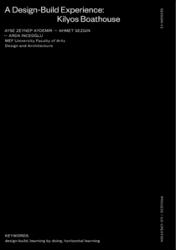Please use this identifier to cite or link to this item:
https://hdl.handle.net/20.500.11779/1308| Title: | A Design-Build Studio: Kilyos Boathouse [2019] |
| Authors: | Aydemir, Ayşe Zeynep Sezgin, Ahmet İnceoğlu, Arda |
| Keywords: | Design-build Horizontal learning Learning by doing |
| Publisher: | TU Delft Open |
| Source: | Aydemir, A.Z., Sezgin, A., & İnceoğlu, A. (2019). A Design-Build Studio: Kilyos Boathouse. EAAE Annual Conference 2019 ‘The Hidden School’ Book of Abstracts. pp. 24-29 |
| Abstract: | As a part of stated curriculum of MEF University Faculty of Arts, Design and Architecture, design-build studio is a compulsory summer internship for the students completing their first year in architecture and interior design. Within the framework of the design-build studio, the school communicates its set of values through emphasising learning by doing, implying horizontal learning and underlining the process. This paper will discuss how a design-build studio can be a distinctive subliminal quality of an architecture faculty through the case of Boathouse project conducted during Summer 2018. Boathouse Project is designed and built at Kilyos Beach in Istanbul by the students completing their first year in architecture and interior design for Boun Marine and Sailing Club to store their equipment such as small sailing catamarans and windsurf boards while providing a space for club members to gather. Thirty-five first-year students, four second and third- year student assistants and three tutors designed and built the project for five weeks with the support by Boğaziçi University for materials and accommodation; ZETAS for ground works; and TORID for timber supply. Boun Marine and Sailing Club members also provided voluntary support for logistics and finishing. Boathouse is awarded both for the Turkish Architecture Yearbook 2018 and Project Awards for Architectural Students in Turkey. One of the most distinctive aspects of the project is learning by doing. Direct engagement enables learning through several processes, and design-build studio is a relevant setting to enhance them. In this context, students grew away from the formal setting and relocated in an unfamiliar context to confront with a real world subject. They were responsible with developing a fully-fledged design proposal, making presentations to communicate with the client, keeping working setup in order as well as the building site, tracking material supply, and building the design in a limited timeframe. Students used woodworking tools after having health and safety training and they undertake the shared work items as workgroups each day. The second aspect of the project is horizontal learning. Instead of delivering top-down instructions, educators’ position was ruling out the hierarchy by working, living and making decisions together. In this sense, working setting was an extension of the studio culture, including sex equality among work sharing, team set-up, and dedication to the project. Moreover, each student was responsible for their work items as well as they were responsible to the whole group. Student assistants were exchanging their experience and knowledge with the first-years while they were sharing the responsibility. They were learning from each other. The third aspect is underlining the process of the project. Within a limited timeframe and limited experience, the process is always emphasised considerably more than the final product. In this context, openness was one of the crucial characteristics that led a direct dialogue with the client through a series of meetings with the Boun Marine and Sailing Club members for developing the design together. During the building phase last- ing three weeks, several adaptations were made as responses to challenges and opportunities. Design-build studio is one of the central characteristics of the school. As a common experience, all of the students get involved in this organisation as early as the first-year; and they become a part of the faculty culture. Participation of all of the tutors in design-build studios also provides an introduction for a mutual acquaintance among students and tutors. Moreover, projects include a social aspect either for community service or for community involvement enhancing the purposefulness which then empower the connection with the real life situations. Overall, the design-build studio setting is a unique subliminal quality for architectural education besides its well-known curricular qualities. |
| URI: | https://hdl.handle.net/20.500.11779/1308 |
| ISBN: | 9789463661966 |
| Appears in Collections: | Mimarlık Bölümü Koleksiyonu |
Files in This Item:
| File | Description | Size | Format | |
|---|---|---|---|---|
| EAAE Zagreb - Book of Abstracts (dragged).pdf | Book of Abstracts | 767.35 kB | Adobe PDF |  View/Open |
CORE Recommender
Sorry the service is unavailable at the moment. Please try again later.
Items in GCRIS Repository are protected by copyright, with all rights reserved, unless otherwise indicated.